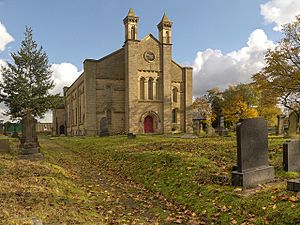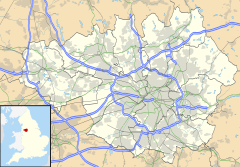Newton, Greater Manchester facts for kids
Quick facts for kids Newton |
|
|---|---|
 St Mary's Church, Newton |
|
| Population | 12,000 (2001) |
| Metropolitan borough | |
| Metropolitan county | |
| Region | |
| Country | England |
| Sovereign state | United Kingdom |
| Post town | HYDE |
| Postcode district | SK14 |
| Dialling code | 0161 |
| Police | Greater Manchester |
| Fire | Greater Manchester |
| Ambulance | North West |
| EU Parliament | North West England |
| UK Parliament |
|
Newton is a small area located in Hyde, Greater Manchester, England. It stretches from the River Tame near Newton Hall all the way to Matley. You can find Newton between the towns of Hyde and Dukinfield.
Newton is actually made up of four smaller sections:
- Newton Green
- Flowery Field
- Newton Moor
- Newton (the main part)
The old Shaw Hall factory used to be located on Matley Lane.
Who Helps Run Newton?
Newton is part of the Stalybridge and Hyde area. This area has a special person who represents it in the UK Parliament. This person is called a Member of Parliament (MP). The current MP for this area is Jonathan Reynolds, who belongs to the Labour Co-operative party.
Newton is also part of the Tameside Metropolitan Borough Council. This council was created in 1974. Its main offices are located in Ashton-Under-Lyne. The council helps manage local services for the people living in Newton and other nearby areas.
Getting Around Newton
Newton has two train stations that help people travel around. These are Newton for Hyde and Flowery Field. Both stations are on the Glossop Line. This train line connects Manchester Piccadilly with Glossop and Hadfield. The trains on this line are run by a company called Northern Trains.
If you prefer to travel by bus, the main bus route in Newton is the 346. This bus connects Hyde with Ashton-Under-Lyne. The bus services are operated by Stagecoach Manchester.
Schools in Newton
Newton has several schools for children of different ages. Here are some of the primary (elementary) and secondary (high) schools in the area:
- Bradley Green Primary School
- Flowery Field Primary School
- Oakfield Primary School
- St Paul's Catholic Primary & Nursery School
- Hyde Community College
Famous People from Newton
One notable person born in Newton was Michael Barber (1934 - 1991). He was a brilliant chemist and a specialist in something called mass spectrometry. He is best known for inventing a method called fast atom bombardment ionisation. Michael Barber was born at 166 Lodge Lane in Newton.



